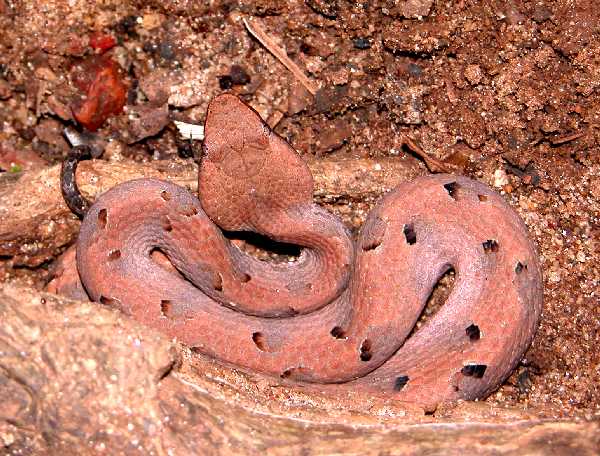- Hypnale
image_caption = Hump-nosed viper, "H. hypnale".
regnum =Animal ia
phylum =Chordata
subphylum = Vertebrata
classis =Reptilia
ordo =Squamata
subordo =Serpentes
familia =Viperidae
subfamilia =Crotalinae
genus = "Hypnale"
genus_authority = Fitzinger, 1843
synonyms = * "Hypnale" - Fitzinger, 1843McDiarmid RW, Campbell JA, Touré T. 1999. Snake Species of the World: A Taxonomic and Geographic Reference, vol. 1. Herpetologists' League. 511 pp. ISBN 1-893777-00-6 (series). ISBN 1-893777-01-4 (volume).]:"Common names: hump-nosed vipers,Gloyd HK, Conant R. 1990. Snakes of the Agkistrodon Complex: A Monographic Review. Society for the Study of Amphibians and Reptiles. 614 pp. 52 plates. LCCN 89-50342. ISBN 0-916984-20-6.] hump-nosed pit vipers.Brown JH. 1973. Toxicology and Pharmacology of Venoms from Poisonous Snakes. Springfield, Illinois: Charles C. Thomas. 184 pp. LCCCN 73-229. ISBN 0-398-02808-7.] ""Hypnale" is a
genus of venomous pitvipers found inSri Lanka and southwesternIndia . Threemonotypic species are currently recognized (no subspecies).ITIS|ID=634415|taxon=Hypnale|year=2006|date=3 November] All members have a more or less upturned snouts that produce a hump-nosed effect.Description
Members of this genus grow to a maximum length of 55 cm (for "H. hypnale"). The body is stout, but relatively slender compared to most other crotalines. The tail length account for 14-18% of total body length in males, 11-16% in females.
The snout is more or less upturned, with two species having a wartlike protuberance at the tip that is covered with tiny scales. The anterior head shields are strongly fragmented, but the
frontal scale ,supraoculars and parietals are complete and quite large. The nasal scale is single, but it may have a groove that extends towards its upper edge. There are twopreoculars and 2-4 postoculars. Theloreal scale is single, but extends across the "canthus rostralis" so that it can be seen from above. Thesupralabials andsublabials both number 7-9. Bordering the supralabials are 3-4 enlargedtemporal scales , above which are 3-5 irregular rows of temporal scales. There is one pair of chin shields, each of which is slightly longer than it is wide.At midbody there are 17 rows of
dorsal scales , which are weakly keeled. Apical pits are present, but very difficult to see. The keels are lacking or may be entirely absent on the first two scale rows bordering the ventrals. Theventral scales number 120-158, while thesubcaudals vary in number from 28-48 (almost all are paired).Geographic range
Found in
Sri Lanka andIndia , from almost sea level to an elevation of at least 1,829 m. In India they are found in theWestern Ghats as far as 16° north latitude.Habitat
They occur in dense jungles, dry forests, rain forests, both in low and hilly country, and in plantations. They sometimes are also found near or in human habitations.
Behavior
Mostly nocturnal, but are often seen coiled in the shade during the day, moving around on cloudy days, or under low light conditions. They are generally inoffensive, both in the wild and in captivity, rarely attempting to bite unless restrained or injured.
Feeding
Their diet includes lizards, snakes, frogs, reptile eggs and small mammals.
Reproduction
All members of this group are viviparous.
pecies
Taxonomy
According to Gloyd and Conant (1990), members of this group seem to be closely related to the genus "
Calloselasma ".ee also
*
List of crotaline species and subspecies
*
*
*Snakebite References
Further reading
* Boulenger, George A. 1890 The Fauna of British India, Including Ceylon and Burma. Reptilia and Batrachia. Taylor & Francis, London, xviii, 541 pp.
* Doblado, R. 2005 Hypnale hypnale - the Indian Humpnose Viper. Reptilia (GB) (38): 64-70
* Gumprecht, A.; Tillack, F.; Orlov, N.L.; Captain, A. & Ryabow, S. 2004 Asian Pit Vipers. Geitje Books, Berlin, 368 pp.
* Parkinson, C.L. 1999 Molecular systematics and biogeographical history of Pit Vipers as determined by mitochondrial ribosomal DNA sequences. Copeia 1999 (3): 576-586External links
*
* [http://calphotos.berkeley.edu/cgi/img_query?query_src=photos_index&enlarge=0000+0000+0103+0052 "Hypnale hypnale"] , image 1/2 at [http://calphotos.berkeley.edu/ CalPhotos] . Accessed30 June 2007 .
* [http://calphotos.berkeley.edu/cgi/img_query?query_src=photos_index&enlarge=0000+0000+0604+0073 "Hypnale hypnale"] , image 2/2 at [http://calphotos.berkeley.edu/ CalPhotos] . Accessed30 June 2007 .
Wikimedia Foundation. 2010.

